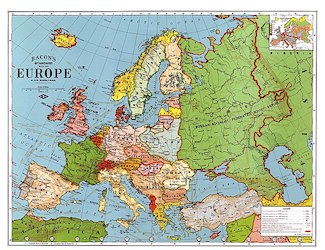
Europe. A continent located entirely in the Northern Hemisphere and mostly in the Eastern Hemisphere. It is bordered by the Arctic Ocean to the north, the Atlantic Ocean to the west, the Mediterranean Sea to the south, and Asia to the east.
Europe shares the landmass of Eurasia with Asia, and of Afro-Eurasia with both Asia and Africa. Europe is commonly considered to be separated from Asia by the watershed of the Ural Mountains, the Ural River, the Caspian Sea, the Greater Caucasus, the Black Sea, and the waterway of the Bosporus Strait.
Europe covers about 2% of Earth’s surface, making it the second-smallest continent. Politically, Europe is divided into about fifty sovereign states, of which Russia is the largest and most populous, spanning 39% of the continent and comprising 15% of its population. Europe had a total population of about 745 million (about 10% of the world population) in 2021; the third-largest after Asia and Africa.
European culture consists of a range of national and regional cultures, which form the central roots of the wider Western civilization, and together commonly reference ancient Greece and ancient Rome.
Beginning with the fall of the Western Roman Empire in 476 CE, Christian consolidation of Europe in the wake of the Migration Period marked the European post-classical Middle Ages. The Italian Renaissance, radiating from Florence, spread to the rest of the continent a new humanist interest in art and science which led to the modern era.
Since the Age of Discovery, led by Spain and Portugal, Europe played a predominant role in global affairs with multiple explorations and conquests around the world. Between the 16th and 20th centuries, European powers colonized at various times the Americas, almost all of Africa and Oceania, and the majority of Asia.
The Age of Enlightenment, the French Revolution, and the Napoleonic Wars shaped the continent culturally, politically and economically from the end of the 17th century until the first half of the 19th century.
The Industrial Revolution, which began in Great Britain at the end of the 18th century, gave rise to radical economic, cultural and social change in Western Europe and eventually the wider world.
Both world wars began and were fought to a great extent in Europe, contributing to a decline in Western European dominance in world affairs by the mid-20th century as the Soviet Union and the U.S. took prominence and competed over dominance in Europe and globally.
The resulting Cold War divided Europe along the Iron Curtain, with NATO in the West and the Warsaw Pact in the East. This divide ended with the Revolutions of 1989, the fall of the Berlin Wall, and the dissolution of the Soviet Union, which allowed European integration to advance significantly.
European integration is being advanced institutionally since 1948 with the founding of the Council of Europe, and significantly through the realization of the European Union (EU), today which represents the majority of Europe. A majority of its members have adopted a common currency, the euro, and participate in the European single market and a customs union.
A large bloc of countries, the Schengen Area, have also abolished internal border and immigration controls. Regular popular elections take place every five years within the EU; they are the second-largest democratic elections in the world after India‘s. The EU is the third-largest economy in the world.